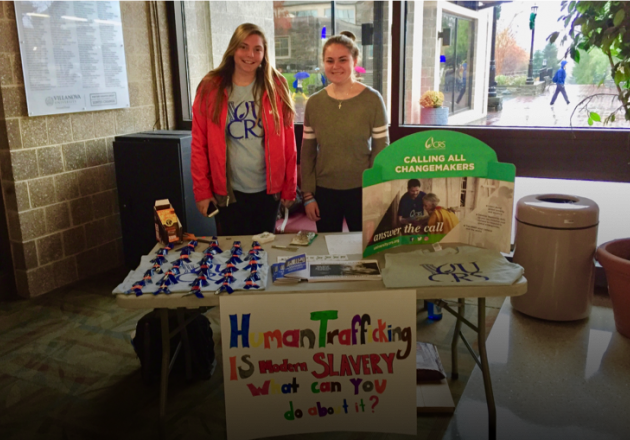America: Land of the Free? Human Trafficking
April 4, 2017
As Catholic Relief Services Ambassadors it is our job to highlight the effects of significant global issues, one being human trafficking. As the semester began and planning for campaigns started, we acknowledged that we had the desire to bring the issue of human trafficking to light. It is the third largest criminal industry worldwide and is the second fastest growing criminal industry in the United States, but few people know what human trafficking is or that it happens in our area.
This week, we held virtual reality viewings in the Connelly Center that allowed the viewer to see what it would be like to be a victim of human trafficking. On Tuesday April 4, we showed the documentary “I am Jane Doe” in the Villanova Cinema. This documentary tells stories of female victims of sex trafficking in the United States. On April 6, there was a Q&A Panel to allow members of the University to come, listen to experts in the area, and ask questions. Linda Copel, Ph.D., from the Villanova College of Nursing, Shea Rhodes from the Villanova Law School, Hugh Organ from the Philadelphia Anti-Trafficking Coalition, a member of the staff at Dawn’s Place in Philadelphia, and a survivor of human trafficking from Dawn’s Place each spoke of their experiences related to human trafficking in Philadelphia and the surrounding area.
We typically hear stories of human trafficking happening across the globe, but last November there were six men arrested for a prostitution sting at the King of Prussia mall. Human trafficking targets vulnerable people in search of bettering their lives, and anyone can fall into its trap. Traffickers rarely recruit their victims by physically kidnapping them. Typically, traffickers recruit their victims by approaching an individual who might need help in their lives, but then exploiting them through prostitution, forced labor, domestic service, slavery or the removal and sale of their organs. This begs the question, is America the land of the free when more people are enslaved today than in all of the African Slave Trade? Female victims earn 632,000 dollars annually through prostitution but receive little if any of the money they make. Male victims who are pushed into forced labor make no little income and are often indebted to their trafficker. Most victims of sex trafficking become victims when they’re young, as young as 12 years old.
What can we do to help? The first step is education and being aware so that we may help give the essential resources through the legal system to victims of human trafficking. Once educated, that knowledge and understanding needs to be spread and made public. More and more people need to know about this issue and even how we can be contributing to it. So talk to your friends and family. Create a ripple effect of awareness that won’t end. On top of this, it is easy to reach out to our senators and representatives. At each of our events we hand out letters that are addressed to our senators to sign bills in favor for helping victims receive the resources needed.











